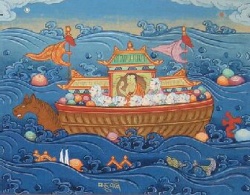Difference between revisions of "Ti-lakkhana"
(Created page with "thumb|250px| <poem> ti-lakkhana: the '3 characteristics of existence', or signata, are impermanency (anicca), suffering or misery (dukkha; s. sacca, d...") |
|||
| Line 1: | Line 1: | ||
[[File:50204.jpg|thumb|250px|]] | [[File:50204.jpg|thumb|250px|]] | ||
<poem> | <poem> | ||
| − | ti-lakkhana: the '3 characteristics of existence', or signata, are impermanency (anicca), | + | ti-lakkhana: the '3 characteristics of existence', or signata, are impermanency (anicca), [[Suffering]] or misery ([[Dukkha]]; s. [[Sacca]], dukkhatā), not-self (anattā). |
| − | "Whether Perfect Ones appear in the world, or whether Perfect Ones do not appear in the world, it still remains a firm condition, an immutable fact and fixed law: that all formations are impermanent, that all formations are subject to | + | "Whether Perfect Ones appear in the world, or whether Perfect Ones do not appear in the world, it still remains a firm condition, an immutable fact and fixed law: that all formations are impermanent, that all formations are subject to [[Suffering]], that everything is without a self'' (A. III, 134). |
| − | "What do you think, o monks: Is corporeality ( | + | "What do you think, o monks: Is corporeality ([[Rūpa]]) permanent or impermanent? - Impermanent, o [[Venerable]] One. - Are feeling (vedanā), [[Perception]] (saññā), mental formations ([[Sankhāra]]) and [[Consciousness]] ([[Viññāna]]), permanent or impermanent? - Impermanent, o [[Venerable]] One. |
| − | "But that which is impermanent, is it something pleasant or painful? - It is painful, o Venerable One. | + | "But that which is impermanent, is it something pleasant or painful? - It is painful, o [[Venerable]] One. |
| − | "But, of what is impermanent, painful and subject to change, could it be rightly said, 'This belongs to me, this am I, this is my ego'? - No, Venerable One. | + | "But, of what is impermanent, painful and subject to change, could it be rightly said, 'This belongs to me, this am I, this is my ego'? - No, [[Venerable]] One. |
| − | "Therefore, whatever there is of corporeality, feeling, | + | "Therefore, whatever there is of corporeality, feeling, [[Perception]], mental formations and [[Consciousness]], whether past, present or future, one's own or external, gross or subtle, lofty or low, far or near, of all these things one should understand, according to reality and true [[Wisdom]]: 'This does not belong to me, this am I not, this is not my ego' " (S. XXII, 59). |
| − | "In one who understands eye, ear, nose, tongue, | + | "In one who understands eye, ear, nose, tongue, [[Body]] and all the remaining formations as impermanent, painful and not-self, in him the [[Fetters]] ([[Samyojana]], q.v.) are dissolved" (S. XXXV, 53). |
It is the full comprehension of the 3 characteristics by direct meditative experience which constitutes liberating insight. About their relation to the three gateways ot liberation', s. vimokkha I . | It is the full comprehension of the 3 characteristics by direct meditative experience which constitutes liberating insight. About their relation to the three gateways ot liberation', s. vimokkha I . | ||
| − | For further details, s. anicca, | + | For further details, s. anicca, [[Dukkha]], anattā, vipassanā. |
Literature: | Literature: | ||
Revision as of 09:37, 29 March 2013
ti-lakkhana: the '3 characteristics of existence', or signata, are impermanency (anicca), Suffering or misery (Dukkha; s. Sacca, dukkhatā), not-self (anattā).
"Whether Perfect Ones appear in the world, or whether Perfect Ones do not appear in the world, it still remains a firm condition, an immutable fact and fixed law: that all formations are impermanent, that all formations are subject to Suffering, that everything is without a self (A. III, 134).
"What do you think, o monks: Is corporeality (Rūpa) permanent or impermanent? - Impermanent, o Venerable One. - Are feeling (vedanā), Perception (saññā), mental formations (Sankhāra) and Consciousness (Viññāna), permanent or impermanent? - Impermanent, o Venerable One.
"But that which is impermanent, is it something pleasant or painful? - It is painful, o Venerable One.
"But, of what is impermanent, painful and subject to change, could it be rightly said, 'This belongs to me, this am I, this is my ego'? - No, Venerable One.
"Therefore, whatever there is of corporeality, feeling, Perception, mental formations and Consciousness, whether past, present or future, one's own or external, gross or subtle, lofty or low, far or near, of all these things one should understand, according to reality and true Wisdom: 'This does not belong to me, this am I not, this is not my ego' " (S. XXII, 59).
"In one who understands eye, ear, nose, tongue, Body and all the remaining formations as impermanent, painful and not-self, in him the Fetters (Samyojana, q.v.) are dissolved" (S. XXXV, 53).
It is the full comprehension of the 3 characteristics by direct meditative experience which constitutes liberating insight. About their relation to the three gateways ot liberation', s. vimokkha I .
For further details, s. anicca, Dukkha, anattā, vipassanā.
Literature:
The Three Signata, by Prof. O. H. de A. Wijesekera (WHEEL 20). -
The Three Basic Facts of Existence: I-III (WHEEL BPS),
Vis.M. XX, 13ff. 18ff; XXI, 47f, 67f
